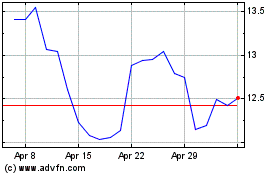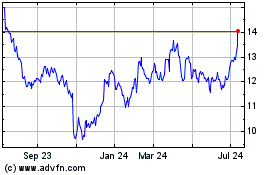Ford Posts Higher Profit, Lifts
July 26 2017 - 9:11AM
Dow Jones News
By Christina Rogers
Ford Motor Co.'s new chief executive is starting his tenure with
the wind at his back, lifting its earnings outlook for the year in
a move that helps address concerns about the company's ability to
weather softer conditions in the U.S. market.
The Dearborn, Mich., auto maker on Wednesday said a
lower-than-expected tax rate, strong pricing on pickup trucks and
SUVs and strengthening conditions for its Ford Credit lending arm
led to a $2 billion net profit for the year, a 4% improvement over
the same period a year ago.
The company issued new guidance, forecasting full-year adjusted
earnings per share between $1.65 and $1.85 with the midrange
roughly in line with last year's results.
Jim Hackett was hired in May after the board ousted Mark Fields,
who had delivered a string of healthy profits over a three-year
tenure as CEO but failed to deliver a clear vision of how the
company will confront a slate of changes threatening to reshape the
auto industry. Ford's stock price also struggled under Mr. Fields,
and analysts expressed concern about a weakening profit
outlook.
Ford's earnings report somewhat mirrored results delivered by
General Motors Co. a day earlier, which were almost entirely driven
by core North American performance.
While overall demand is waning in the U.S. market, buyers
continue to snap up pricey pickup trucks and sport utilities amid
lower gasoline prices, a favorable development for Detroit auto
makers that have a lock on the big pickup market and make a
disproportionate amount of profit from vehicles like the F-150 or
Explorer.
"The company grew this quarter," Chief Financial Officer Bob
Shanks told reporters Wednesday morning.
Ford's second-quarter adjusted earnings were 56 cents a share,
beating analysts' estimates of 43 cents a share. Ford attributed
the beat to a lower-than-expected tax rate due to changes in the
way it accounts for losses incurred by the company's overseas
operations.
Operating income fell 16% to $2.5 billion in the second quarter
due to higher commodity costs, unfavorable exchange rates in China
and Europe and one-time charges related to a pullback in small-car
production, including the cancellation of a new assembly plant in
Mexico earlier this year.
Revenue was $39.9 billion for the April-to-June period versus
$39.5 billion a year ago, despite weaker global volumes, including
a 3% decline in the U.S. new-car sales in the U.S. in the
second-quarter and lower deliveries in Europe due to the changeover
to a new Fiesta small car.
North American operating profits were $2.2 billion, down $500
million from the previous year. Margins in the region also slipped
in the second quarter to 9%, down from 11.3% a year earlier.
In Europe, Ford posted a pretax profit of $88 million compared
with $467 million a year ago with earnings dented by lower sales
and an unfavorable exchange rate due to Brexit.
In Asia Pacific, Ford swung to a $143 million operating profit
from a year-earlier loss of $8 million, as sales and market share
in China improved during the quarter.
Ford's operating loss in South America continued to narrow, with
the auto maker reporting $185 million in red ink for the just-ended
quarter, compared with a year-earlier loss of $265 million.
Write to Christina Rogers at christina.rogers@wsj.com
(END) Dow Jones Newswires
July 26, 2017 08:56 ET (12:56 GMT)
Copyright (c) 2017 Dow Jones & Company, Inc.
Ford Motor (NYSE:F)
Historical Stock Chart
From Mar 2024 to Apr 2024

Ford Motor (NYSE:F)
Historical Stock Chart
From Apr 2023 to Apr 2024
